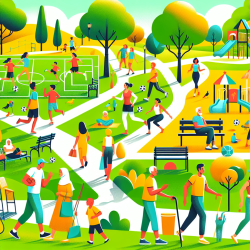Introduction
Parks play a crucial role in promoting physical activity, especially in low-income, African American neighborhoods. A recent study titled "The Relationships between Park Quality, Park Usage, and Levels of Physical Activity in Low-Income, African American Neighborhoods" provides valuable insights into how park quality influences physical activity levels. This blog will explore the study's findings and offer practical recommendations for practitioners looking to enhance park usage and physical activity in their communities.
The Study: Key Findings
The study conducted observational research in 31 parks within low-income, African American neighborhoods in New Orleans, Louisiana. The researchers examined the relationships between park quality, park usage, and physical activity levels. Key findings include:
- Parks with signs of disorder, such as litter and graffiti, had 49% fewer female users.
- Attractive parks had 146% more female users.
- Park attractiveness and the number of activity settings were positively associated with park usage among youth.
These findings highlight the importance of park maintenance and attractiveness in encouraging park usage and physical activity, particularly among women and youth.
Practical Recommendations for Practitioners
Based on the study's findings, practitioners can take several steps to improve park usage and physical activity levels in their communities:
- Enhance Park Maintenance: Regularly clean and maintain parks to reduce signs of disorder, such as litter and graffiti. This can help create a safer and more inviting environment for park users.
- Improve Park Attractiveness: Invest in landscaping and visual appeal to make parks more attractive. Consider adding flowers, trees, and other aesthetic elements to enhance the park's overall appeal.
- Increase Activity Settings: Add or improve activity settings, such as playgrounds, sports fields, and walking paths, to encourage physical activity among youth and adults.
Encouraging Further Research
While this study provides valuable insights, further research is needed to explore the impact of park quality on physical activity in different settings and populations. Practitioners are encouraged to conduct their own research and collaborate with local communities to gather data and develop tailored interventions.
Conclusion
Improving park quality is a low-cost environmental strategy that can significantly boost park usage and physical activity levels, particularly among women and youth in low-income, African American neighborhoods. By investing in park maintenance, attractiveness, and activity settings, communities can create healthier and more active environments for their residents.
To read the original research paper, please follow this link: The Relationships between Park Quality, Park Usage, and Levels of Physical Activity in Low-Income, African American Neighborhoods










